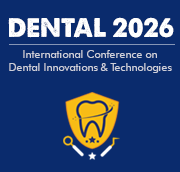Keynote Presentation (In-Person)
David Geoffrey Gillam, Queen Mary University of London, United Kingdom
Molar-incisor hypomineralisation (MIH) is a developmental enamel defect of systemic origin that presents both diagnostic and therapeutic challenges in dentistry. Despite its increasing prevalence, several studies indicate some variability in clinicians’ knowledge, confidenc [....] » Read More



Title : Efficacy of a biomin F toothpaste compared to conventional toothpastes in remineralisation and dentine hypersensitivity: An overview
David Geoffrey Gillam, Queen Mary University of London, United Kingdom
Dentine hypersensitivity (DH) and enamel demineralisation are prevalent oral health concerns. BioMin toothpaste, containing fluoro-calcium phosphosilicate (FCPS), has emerged as a potential alternative to conventional toothpastes for both remineralisation and DH management. This [....] » Read More
Title : Dental treatment of 1,500 young children under general anesthesia
Jaap Boehmer, Rijnstate Hospital, Netherlands
Will be Updated Soon...